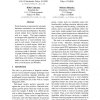11 search results - page 2 / 3 » An Experimental Study on Unsupervised Graph-based Word Sense... |
ACL
2010
13 years 2 months ago
2010
Word Sense Disambiguation remains one of the most complex problems facing computational linguists to date. In this paper we present a system that combines evidence from a monoling...
BMCBI
2010
13 years 4 months ago
2010
Background: Word sense disambiguation (WSD) algorithms attempt to select the proper sense of ambiguous terms in text. Resources like the UMLS provide a reference thesaurus to be u...
EMNLP
2006
13 years 6 months ago
2006
Word clustering is important for automatic thesaurus construction, text classification, and word sense disambiguation. Recently, several studies have reported using the web as a c...
SIGIR
2005
ACM
13 years 10 months ago
2005
ACM
This paper presents an algorithm for unsupervised noun sense induction, based on clustering of Web search results. The algorithm does not utilize labeled training instances or any...
COLING
2010
12 years 11 months ago
2010
Word Sense Disambiguation (WSD) often relies on a context model or vector constructed from the words that co-occur with the target word within the same text windows. In most cases...

